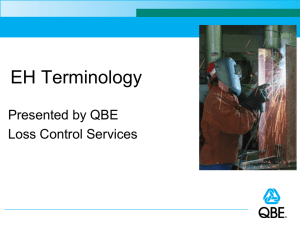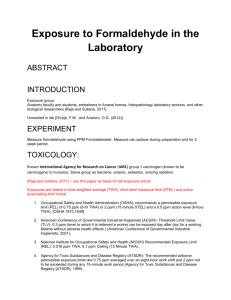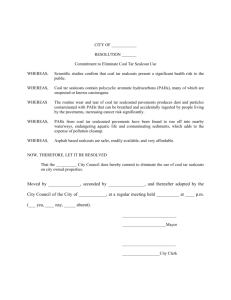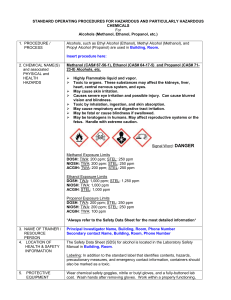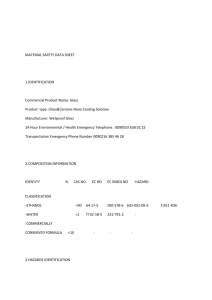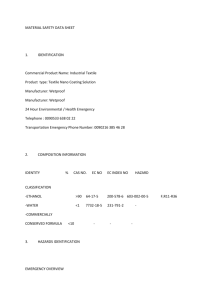WD 2000 ™ MSDS - Lone Star Specialties
advertisement
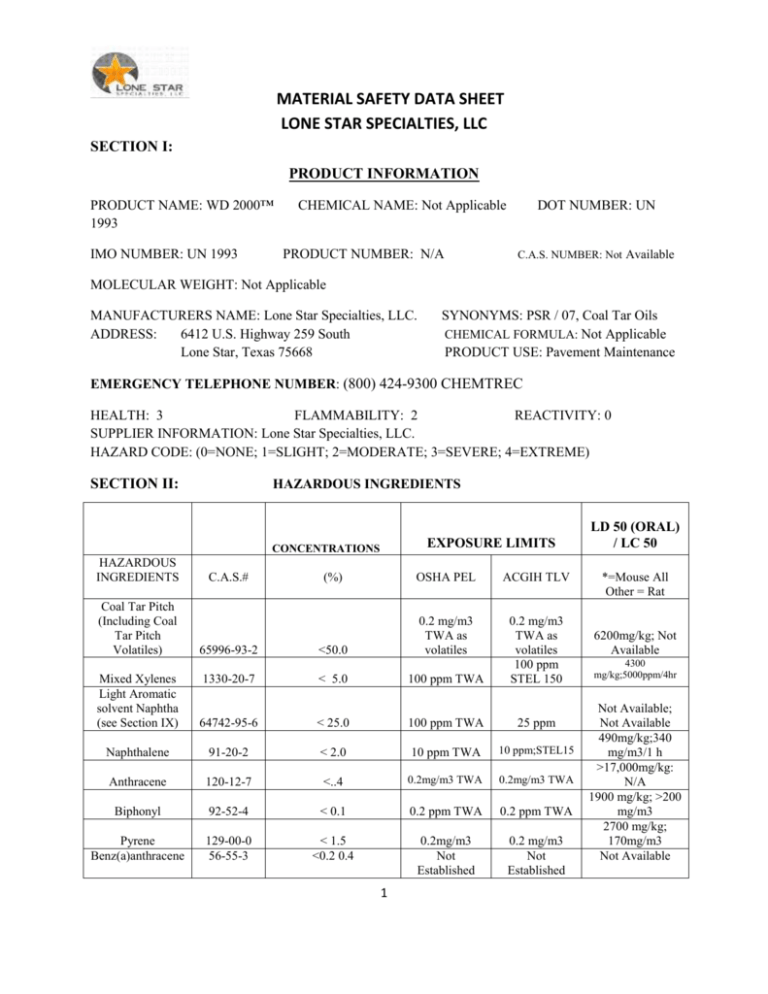
MATERIAL SAFETY DATA SHEET LONE STAR SPECIALTIES, LLC SECTION I: PRODUCT INFORMATION PRODUCT NAME: WD 2000™ 1993 IMO NUMBER: UN 1993 CHEMICAL NAME: Not Applicable PRODUCT NUMBER: N/A DOT NUMBER: UN C.A.S. NUMBER: Not Available MOLECULAR WEIGHT: Not Applicable MANUFACTURERS NAME: Lone Star Specialties, LLC. ADDRESS: 6412 U.S. Highway 259 South Lone Star, Texas 75668 SYNONYMS: PSR / 07, Coal Tar Oils CHEMICAL FORMULA: Not Applicable PRODUCT USE: Pavement Maintenance EMERGENCY TELEPHONE NUMBER: (800) 424-9300 CHEMTREC HEALTH: 3 FLAMMABILITY: 2 REACTIVITY: 0 SUPPLIER INFORMATION: Lone Star Specialties, LLC. HAZARD CODE: (0=NONE; 1=SLIGHT; 2=MODERATE; 3=SEVERE; 4=EXTREME) SECTION II: HAZARDOUS INGREDIENTS EXPOSURE LIMITS CONCENTRATIONS HAZARDOUS INGREDIENTS Coal Tar Pitch (Including Coal Tar Pitch Volatiles) C.A.S.# (%) OSHA PEL ACGIH TLV <50.0 0.2 mg/m3 TWA as volatiles Mixed Xylenes Light Aromatic solvent Naphtha (see Section IX) 1330-20-7 < 5.0 100 ppm TWA 0.2 mg/m3 TWA as volatiles 100 ppm STEL 150 64742-95-6 < 25.0 100 ppm TWA 25 ppm Naphthalene 91-20-2 < 2.0 10 ppm TWA 10 ppm;STEL15 Anthracene 120-12-7 <..4 0.2mg/m3 TWA 0.2mg/m3 TWA Biphonyl 92-52-4 < 0.1 0.2 ppm TWA 0.2 ppm TWA Pyrene Benz(a)anthracene 129-00-0 56-55-3 < 1.5 <0.2 0.4 0.2mg/m3 Not Established 0.2 mg/m3 Not Established 65996-93-2 1 LD 50 (ORAL) / LC 50 *=Mouse All Other = Rat 6200mg/kg; Not Available 4300 mg/kg;5000ppm/4hr Not Available; Not Available 490mg/kg;340 mg/m3/1 h >17,000mg/kg: N/A 1900 mg/kg; >200 mg/m3 2700 mg/kg; 170mg/m3 Not Available MATERIAL SAFETY DATA SHEET LONE STAR SPECIALTIES, LLC SECTION III: PHYSICAL DATA PHYSICAL STATE: SOLID LIQUID X GAS pH Not Available VAPOR PRESSURE @ 20C: Not Available ODOR & APPREARANCE: Black liquid with a coal tar odor. FREEZING POINT: Not Available SPECIFIC GRAVITY: <1.12@ 25 C. SOLUBILITY (WATER): Negligible ODOR THRESHOLD: Not Available DENSITY: Not Available EVAPORATION RATE: Not Available VAPOR DENSITY: Not Available MELTING POINT: Not Available BOILING POINT: Not Available COEFFICIENT OF WATER/OIL DISTRIBUTION: Not Available VOC Content: < 340 g/l or 2.8 lbs/gal SECTION IV: REACTIVITY DATA PHYSICAL (REACTIVITY) HAZARD WARNING: Not Applicable STABLE: Yes IF NO, UNDER WHICH CONDITIONS: INCOMPATABILITIES: None Known REACTIVE: No IF YES, UNDER WHICH CONDITIONS: HAZARDOUS DECOMPOSITION PRODUCTS: Not Applicable SECTION V: FIRE AND EXPLOSION HAZARDS PHYSICAL HAZARD WARNING: Combustible Liquid SENSITIVITY TO > STATIC DISCHARGE YES: MECHANCIAL IMPACT: No FLAMMABLE: Yes IF YES, WHICH CONDITIONS: Flame, Sparks FLASHPOINT (METHOD): 128ºF. FLAMMABLE LIMITS (% BY VOL.): UEL: Not Available LEL: Not Available AUTO IGNITION TEMPERATURE: Not Available 2 MATERIAL SAFETY DATA SHEET LONE STAR SPECIALTIES, LLC HAZARD COMBUSTION PRODUCTS: Irritating and/or toxic fumes may be released if this material is burned. MEANS OF EXTINCTION: Water fog, foam, carbon dioxide, dry chemical UNUSUAL FIRE/EXPLOSION HAZARDS: Product will degas (generates flammable gas) when heated. Closed containers may explode when exposed to extreme heat. Vapors are heavier than air may travel along the ground, pit or sewer line to some distant source of ignition and flash back. SPECIAL FIRE FIGHTING PROCEDURES: Wear complete fire service protective equipment, including full-face MSHA/NIOSH approved self-contained breathing apparatus. Use water to cool fire exposed container/structure/protect personnel. Toxic vapors may be given off in a fire. SECTION VI: TOXICOLOGICAL PROPERTIES HEALTH HAZARD WARNINGS: Carcinogen, Irritant, Sensitizer ROUTES OF ENTRY > SKIN CONTACT: X SKIN ABSORPTION: X EYE CONTACT: X INHALATION: X INGESTION: X EFFECTS OF ACUTE EXPOSURE: Coal tar pitch vapors are irritating to the skin, eyes, and respiratory tract. Direct skin contact with high vapor concentrations may cause burning and itching, changes in pigmentation, and skin eruptions. Direct contact with the product may cause inflammation, discomfort, conjunctivitis, and possible abrasion. In general, acute oral toxicity is assumed to be moderate, but ingestion is not likely to be a primary route of exposure. Symptoms of systemic poisoning after ingestion of other coal tar products include salivation, vomiting, respiratory difficulties, dizziness, and headache, loss of papillary reflexes, cyanosis, hypothermia, and mild convulsions. It is assumed that ingestion of this product would produce similar symptoms. The presence of solvents in this material may lead to central nervous system effects with symptoms similar to those caused by systemic poisoning after ingestion of coal tar. Symptoms include gastrointestinal irritation, nauseas, vomiting, and diarrhea. IRRITANCY OF PRODUCT: photosensitization Minor skin irritant, SENSITIZATION TO PRODUCT: Causes EFFECTS OF CHRONIC EXPOSURE: High vapor concentrations or chronic exposure to levels above the TLV may lead to systemic symptoms (See acute oral toxicity symptoms). Prolonged or repeated contact may lead to dermatitis and with poor hygienic practices, to skin cancer. 3 MATERIAL SAFETY DATA SHEET LONE STAR SPECIALTIES, LLC CARCINOGEN: X REPRODUCTIVE EFFECTS :} BRIEF DESCRIPTION: Prolonged or repeated contact, along with poor hygienic practices, may lead to cancer. TERATOGENICITY: MUTAGENICITY SYNERGISTIC MATERIALS: None Known MEDICAL CONDITIONS AGGRAVATED: Persons with pre-existing skin disorders may be at increased risk from overexposure. Exposure to vapors may aggravate pre-existing lung conditions. SECTION VII: FIRST AID MEASURES SKIN: Wash exposed area twice with waterless hand cleaner, soap and water, or a mild detergent. Do not use solvents on skin as they may promote absorption of this material. The exposed area should be examined by medical personnel if irritation or pain persists after washing. EYE: Flush eyes immediately with large amount of water for at least 15 minutes, occasionally lifting the eyelids. GET MEDICAL ATTENTION. INHALATION (BREATHING): Remove from exposure area to fresh air immediately. If breathing has stopped, give artificial respiration. Keep affected person warm and rest. Give oxygen if respiration is shallow. GET MEDICAL ATTENTION. INGESTION: (SWALLOWING) if conscious, DO NOT induce vomiting, Give oxygen if respiration is shallow. GET MEDICAL ATTENTION. Do not give anything by mouth to an unconscious person. DECONTAMINTATION PROCEDURES: Use emergency shower if available. Remove all contaminated clothing to prevent further absorption. Wash all clothing and exposed areas of the body twice with soap and water. Leather shoes that have been saturated should be discarded. SECTION VIII: PREVENTIVE MEASURES PERSONAL PROTECTIVE EQUIPMENT: GLOVES (Impervious Rubber), FOOTWEAR: (Impervious Boots) EYES: Chemical goggles or face shield where necessary. 4 CLOTHING: (Impervious Suits) MATERIAL SAFETY DATA SHEET LONE STAR SPECIALTIES, LLC RESPIRATOR: NIOSH approved half-face piece or full-face piece filter/chemical cartridge respirator or full-face continuous flow, positive pressure air supplied respirator as necessary for protection from coal tar pitch volatiles. OTHER: Not applicable PERSONAL HYGIENE PRACTICES: Contact lenses should not be worn when handling this material. Do not smoke or eat in areas where this material is handled. Wash hands thoroughly before eating or smoking. A complete soap and water shower should be taken at the end of each work day. Contaminated work clothes should not be reworn until cleaned. ENGINEERING CONTROLS: All operations should be conducted in well-ventilated conditions. Local exhaust ventilation should be provided. LEAK AND SPILL PROCEDURE: Remove all ignition sources. Ventilate area of spill or leak. Release of solid material can be handled in the same manner as a coal spill. If hot liquid is spilled, contain with suitable absorbent material (e.g. sand, earth, etc.) allow cooling, collecting material, and then dispose of properly. Wear protective equipment during clean-up. After collection of material, flush area with water. WASTE DISPOSAL METHOD: Dispose of the material in accordance with standard practice for disposal of potentially hazardous materials as required by applicable federal, state and local laws. Wear protective equipment as necessary. HANDLING PROCEDURES AND EQUIPMENT: Wear protective equipment when performing maintenance on contaminated equipment. Protect containers against physical damage. STORAGE REQUIREMENTS: Outside or detached storage is preferable. Inside storage should be in standard flammable liquids storage room or cabinet if material is flammable or combustible. SPECIAL SHIPPING INFORMATION: DOT DESCRIPTION: BULK SHIPMENTS – Flammable Liquid, n.o.s., (Contains Coal Tar Pitch 50%), 3, UN 1993, PG III, RQ (Benz (a) Anthracene). NON BULK - Flammable Liquid, n.o.s., (Contains Coal Tar Pitch 50%), 3, UN 1993, PG III. IMO: Flammable Liquid, n.o.s., 3.3, UN 1993, PG III, (Contains Coal Tar Pitch 50%), if in bulk, add RQ, (Benz (a) Anthracene). 5 MATERIAL SAFETY DATA SHEET LONE STAR SPECIALTIES, LLC SECTION IX: ADDITIONAL COMMENTS This product contains substances known by the State of California to cause cancer. Light Aromatic Solvent Naphtha contains the following hazardous ingredients: LD 50(ORAL) / COMPOUND CAS# OSHA PEL ACGIG TLV LC50 (RAT) 1,2,45000 mg/kg; Trimethylbenzene 95-63-6 25 ppm TWA 25 ppm TWA 18g/m ¾ hr. 100ppm; STEL4300 mg/kg; 5000 Mixed Xylenes 1330-20-7 100 ppm TWA 150 ppm ppm / 4 hr. 50 ppm TWA 50 ppm TWA 1400 mg/kg; Cumene 98-82-8 (Skin) (Skin) >8000ppm / 4 hr. Hazardous Materials Guidebook Number: 128 (FMS # 3-07 Mfag# None) SECTION 313 SUPPLIER NOTIFICATION > This product contains the following toxic chemicals subject to the reporting requirements of Section 313 of the Emergency Planning and Community Right to Know Act of 1986 and of 40 CFR 372: C.A.S. # 91-20-2 120-12-7 92-52-4 132-64-9 12-00-0 91-22-5 1330-20-7 95-63-6 98-82-8 CHEMICAL NAME Naphthalene Anthracene Biphenyl Dibenzofuren Pyrene Quinoline Xylene 1, 2, 4-Trimethylbenzene Cumene %BY WEIGHT < 2.0 < 0.4 < 0.1 < 5.0 < 1.5 0.5 < 10.0 < 8.0 < 0.5 Based upon the criteria set forth in Section 34 through 36 of the Controlled Products Regulation of Canada, this product is classified as: Class D, Division 2, Subdivision A: Very Toxic Material 6 MATERIAL SAFETY DATA SHEET LONE STAR SPECIALTIES, LLC PRECAUTIONARY STATEMENT: Personnel should avoid inhalation of vapors and personal contact with compound. Do not get the compound in the eyes or skin. When handling, this compound must be kept away from all sources of ignition. Have a respirator available. May be harmful if swallowed or inhaled in large amounts. Please note that the information contained herein is furnished without warranty of any kind. Users should consider these data only as a supplement to other information gathered by them and must make independent determinations of suitability and completeness of information from all sources to assure proper use and disposal of these materials and the safety and health of employees and customers. SECTION X: PREPARATION INFORMATION Prepared By: Chris O. Smith Phone Number: (800) – 256 - 2032 Date: January 15, 2010 Updated: May 1, 2011 added VOC content information Section III 7
